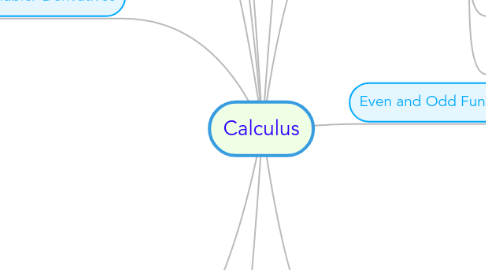
1. Laws
1.1. REPLACEMENT LAW ASSUME that : f(x) = g(x) , x NOT EQUAL TO a Then, 1) lim f(x) = lim g(x) OR 2) no limits exist
2. CONTINUITY
2.1. Definition of Continuous Function
2.1.1. a ε dom(f)
2.1.2. lim f(x) exists
2.1.2.1. Use ONE SIDED LIMITS TO PROVE (RHS = LHS)
2.1.3. lim f(x) = f(a)
2.2. Pass Limits into Continuous Functions (Theorem)
2.2.1. ASSUME that 1) lim g(x) exists
2.2.2. 2) f is continuous at lim g(x)
2.2.3. THEN lim f ( g(x) ) = f ( lim g(x) )
2.3. Compositions of Continuous Functions (Theorem)
2.3.1. ASSUME that 1 ) g(x) is continuous at a
2.3.2. 2) f(x) is continuous at g(a)
2.3.3. THEN : (F o G)(x) is continuous at a
2.4. Continuous on an interval , IVT THEOREM - F IS A FUNCTION - N,a,b ε R with a < b
2.4.1. ASSUME that : f is continuous on a closed interval [ a,b]
2.4.2. f(a) NOT EQUAL TO f(b)
2.4.3. N lies between f(a) and f(b)
2.4.4. THEN : There exists a number c s.t. 1) a < c < b 2) f(c) = N
3. Differentiable/ Derivatives
3.1. Definition of ' Derivative at a '
3.1.1. f'(a) = lim f( a+h) - f(a)
3.1.1.1. IF LIMIT EXISTS, f(a) IS DIFFERENTIABLE AT a, if limits DNE, DERIVATIVE IS NOT DEFINED AT a NOTE: THIS ACTUALLY ALSO MAKES UP THE DEFINITION OF ' THE DERIVATIVE FUNCTION '
3.1.1.1.1. Theorem : If a function f is differentiable at point a, it is continuous at a.
3.2. Useful rules
3.2.1. Power Rule
3.2.1.1. Let n ε N , and x,a ε R ,
3.2.1.2. THEN: (x-n)(x ) = x - a
3.2.2. Product Rule
3.2.2.1. ASSUME that : f(x) is differentiable at point a
3.2.2.2. g(x) is differentiable at a
3.2.2.3. THEN: f(x)g(x) is also differentiable at a
3.2.2.3.1. [ f(x)g(x) ] ' = f'(a)g(a) + f(a)g'(a)
4. L' Hopital Rule
4.1. SUPER IMPORTANT!!! ONLY APPLIES ON LIM 0/0
4.1.1. DIFFERENTIATE TOP AND BOTTOM INDIVIDUALLY (leave in the same form)
4.1.2. STATE THAT YOU ARE USING L'HOPITAL RULE
5. ROLLE'S THEOREM Note: - a and b are the EXTREME VALUES
5.1. Within closed interval [ a ,b ]
5.2. Continuous in [ a , b ]
5.2.1. USE ONE SIDED LIMITS TO CHECK, LHS = RHS
5.3. Differentiable in ( a , b )
5.3.1. Check whether dx/dy is defined at every point within interval
5.3.1.1. Basically dy/dx DENOMINATOR NOT EQUAL TO 0
5.4. Check f(a) , f(b) and f'(c) = 0
6. TRIGO LIMIT IDENTITIES ALWAYS MANIPULATE TRIGO LIMITS QN TO BE ABLE TO USE THESE IDENTITIES ( OFTEN TAN = SIN/COS )
6.1. lim cos(x) - 1 = 0
6.2. lim sin(x) = 1
7. Tangent
7.1. To have a tangent at a point of a graph, limit of tangent at that point must exist( Acc. to definition of the tangent to the graph) Therefore, , where the tangent line passes through ( , )
7.2. dy/dx = 0 , gradient = 0
7.2.1. Turnings points of curves
7.2.2. Points of Inflexions - Different from turnings points as the RHS and LHS of turning points goes opp directions ( 1 up 1 down )
8. Limit Laws
8.1. Sums : lim f(x) exists , lim g(x) exists Then, lim( f(x) + g(x) exists and = lim f(x) + lim g(x)
8.2. Products : lim f(x) exists , lim g(x) exists Then, lim f(x)g(x) exists and = lim f(x) * lim g(x)
8.3. Quotients : lim f(x) exists, lim g(x) exists and lim g(x) NOT EQUAL TO 0 Then,
8.4. Simple Functions : a,c ε R 1) lim c = c 2) lim x = a
8.5. Differences : lim f(x) exists, lim g(x) exists Then, lim ( f(x) - g(x) ) exists and = lim f(x) - lim g(x)
8.6. Roots : Let a ε R , a > 0 and n ε N , lim x ^ 1/n = a ^ 1/n
9. Even and Odd Functions
9.1. Even : f(-x) = f(x)
9.2. Odd : f(-x) = -f(x)
10. Theorems
10.1. ONE SIDED LIMITS IFF lim f(x) = lim f(x) = lim f(x)
10.2. COMPARISON THEOREM lim f(x) exists, lim g(x) exists , f(x) < g(x) for all x in the neighbourhood of a except for a itself Then, lim f(x) < lim g(x)
10.2.1. SQUEEZE THEOREM lim g1(x) exists , lim g2(x) exists, lim g1(x) = g2(x) g1(x) < f(x) < g2(x) for all x in the neighbourhood of a except for a itself Then, 1) limf(x) exists 2) lim f(x) = lim g1(x) = lim g2(x)
10.3. FUNCTIONS HAVE UNIQUE LIMITS If lim f(x) = K AND lim g(x) = L Then, K = L
11. Not within mindmap
11.1. Format of estimation answer
11.1.1. POSITIVE Infinite Limit
11.1.2. NEGATIVE Infinite Limit
11.1.3. Limits from the LEFT
11.1.4. Limits from the RIGHT
